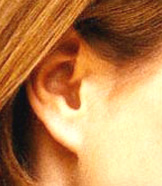摘要:听觉是由位于耳朵内毛发细胞顶端的微小纤毛束运动产生,尽管沉浸在内耳的粘液中,这些“静纤毛”还是对原子尺度的运动很敏感。在微纳米水平上,牛蛙的“静纤毛”进行各种力的平衡测试,分析得出,在听觉允许的频率范围内,“毛发束”的大多数“静纤毛”协同运动,随着频率的增强,会逐渐带动更多的“静纤毛”运动,知道整个“毛发束”一起运动。

听觉是怎样产生的
生物探索推荐英文摘要
Nature doi:10.1038/nature10073
Forces between clustered stereocilia minimize friction in the ear on a subnanometre scale
Abstract: The detection of sound begins when energy derived from an acoustic stimulus deflects the hair bundles on top of hair cells1. As hair bundles move, the viscous friction between stereocilia and the surrounding liquid poses a fundamental physical challenge to the ear’s high sensitivity and sharp frequency selectivity. Part of the solution to this problem lies in the active process that uses energy for frequency-selective sound amplification2, 3. Here we demonstrate that a complementary part of the solution involves the fluid–structure interaction between the liquid within the hair bundle and the stereocilia. Using force measurement on a dynamically scaled model, finite-element analysis, analytical estimation of hydrodynamic forces, stochastic simulation and high-resolution interferometric measurement of hair bundles, we characterize the origin and magnitude of the forces between individual stereocilia during small hair-bundle deflections. We find that the close apposition of stereocilia effectively immobilizes the liquid between them, which reduces the drag and suppresses the relative squeezing but not the sliding mode of stereociliary motion. The obliquely oriented tip links couple the mechanotransduction channels to this least dissipative coherent mode, whereas the elastic horizontal top connectors that stabilize the structure further reduce the drag. As measured from the distortion products associated with channel gating at physiological stimulation amplitudes of tens of nanometres, the balance of viscous and elastic forces in a hair bundle permits a relative mode of motion between adjacent stereocilia that encompasses only a fraction of a nanometre. A combination of high-resolution experiments and detailed numerical modelling of fluid–structure interactions reveals the physical principles behind the basic structural features of hair bundles and shows quantitatively how these organelles are adapted to the needs of sensitive mechanotransduction.







